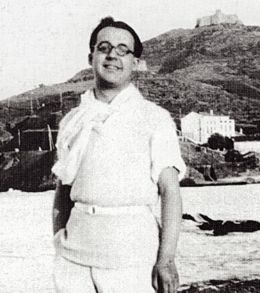Remembering Robert Brasillach,
March 31, 1909–February 6, 1945:
Robert Brasillach & Notre avant-guerre
La Cagoule
Margot Metroland
1,538 words
Editor’s Note: Today marks the 114th birthday of Robert Brasillach, the French journalist, novelist, film historian, and man of the Right who was sentenced to death and executed by firing squad for “intellectual crimes” he was alleged to have committed as a German collaborator during the Second World War. The following translation is offered as a commemoration, and links to other resources regarding Brasillach’s life and work are at the end.
Preface
Here is another section from Notre avant-guerre (approximately, Our Pre-War Years) by Robert Brasillach. The four earlier installments are here.
Some of the passages in this memoir were lifted from Brasillach’s journalism, mainly from the latter 1930s. I’ve noticed that two were originally written for Revue Universelle or Je Suis Partout, but others, such as the following, are de novo exposition. In this excerpt, Brasillach is mainly discussing the Rightist organizations of the mid-1930s — the nationalist, anti-Communist, and monarchist ligues that were suppressed by fiat, by the Popular Front (i.e., socialist and Communist) government under Léon Blum in 1936.
In their place sprang up new political parties and semi-secret societies. Of the latter, the most significant is La Cagoule (“the cowl,” or “the hood”). If you look it up, you may find it referred to as a terrorist organization. TIME magazine first referred to it (in the issue of November 29, 1937) as a “fabulous, supposedly extreme Rightist French Ku Klux Klan.” That’s a bit of a stretch, seeing as Cagoulards were largely Catholic alumni of Charles Maurras’ Action Française.
The TIME story I’m looking at is about the arrest of Cagoule members, and seizure of caches of machine guns and rifles by the French Sûreté. It was believed, or suspected — or perhaps merely trumpeted to the popular press — that the Cagoulards were planning a coup. TIME, however, treats it all as rather a joke, capping the story with:
This week the Duc de Guise, bewhiskered pretender to the vanished throne of France, attempted from his Belgian exile to create an impression that what was afoot was a coup to crown him. “We have decided,” royally manifestoed Guise again, as he often has before, “to reconquer the throne of our fathers.”
The attitude toward La Cagoule among French politicians and journalists wasn’t quite so supercilious. As Brasillach tells us below, fear of Cagoulards was used to demonize and caricature the French Right as a whole in much the same way that the American Left has demonized Trump supporters (or simply “Republicans”) as a dangerous mob of gun-toting, terroristic booboisie.
As we return to our story here, we find Brasillach has been talking about another pretender to the French throne, Henri d’Orleans, Comte de Paris (1908-1999) a popular public figure in the mid-1930s. Henri is the direct descendant of a younger brother of Louis XIV: Philippe, Duc d’Orleans (1640-1701). The main Bourbon line, the so-called “Legitimists” (Louis XIV’s descendants), finally died out in the 1880s, leaving their Orleans cousins as the primary claimants to the throne. The Action Française and other nationalist and monarchist political factions were watching him with fervent interest. Henri was an aviator, with a very handsome family, Brasillach told us in the previous installment, and he publishes a monarchist newspaper, the Courrier Royal.
But as we rejoin the story, there is some disappointing news . . .
From Notre avant-guerre:
The following year [i.e., 1937] we were astonished to discover that the Comte de Paris had condemned Action Française in the course of a manifesto. No doubt his advisers had persuaded him that his cause would be served by abandoning this discredited party. What happened, happened: and people on the Left weren’t broken up by it, that’s for sure. And so that old wrestler, Charles Maurras, suffered yet another blow. We consoled ourselves by repeating to ourselves that the King’s character did not matter, that ingratitude is a royal virtue, and that time arranges many things.

You can buy North American New Right vol. 2 here
And there was other bad news. There was the great [Francois de] La Rocque defamation lawsuit, where the leader of the Parti Social Français[1] was accused of having received funds from Prime Minister Tardieu.[2]
Disgusted with all the political parties, some adventurous young people looked for something else. They organized secret societies, in the style of the Carbonari. The first ones were some dissidents from Action Française who got hosed down by the police, in the usual fashion. This baptism gave them the ironic name Cagoulards.[3] Meanwhile, out in the provinces, they were founding societies to fight against Communism. Everyone knew that there was coordination between the organizations’ commandants and the towns’ civic leaders to prevent a sudden uprising or coup, but otherwise these groups were very different from each other. The police surveilled them all the time, while the Marxists did their best to spread lies and confusion. One fine day, a vast conspiracy against the Republic would supposedly be launched with great fanfare, and only the Cagoulards knew what the next chapter of the story would bring.
Some very good people got arrested, even authentic heroes. For example, General Duseigneur,[4] who would disappear at the beginning of the coming war; or Sergeant Darnand,[5] thanks to whom a forthcoming German offensive in July 1918 was revealed. And yet, personally I never knew any Cagoulard, of any kind whatsoever.
Nevertheless, one knew that these enigmatic and varied organizations were shot through with police informers, scoundrels, fanatics, and dimwits — even if the majority were just brave young men driven by a need for virtuous activism. The end result was that everything on the nationalist side looked confused — defensive organizations got lumped in with Carbonari — while simultaneously the strongly disciplined and ordered Communist cells were themselves accumulating caches of armaments and plotting intricate conspiracies. Thus, for two or three years La Cagoule functioned as a scarecrow for the Popular Front, with the Left blaming it for everything.
But that was just an indication of how mixed up people were in those years, caught in a kind of romantic despair that seized many patriots. At the same time, André Tardieu abandoned politics entirely and published books about the parliamentary regime’s incompetence.
One encouraging development, however, was the emergence of Jacques Doriot.[6] I’d always been curious about his character, this skinny, hairy little devil of whom the bourgeoisie were so afraid, and also the most outstanding leader of the Communist Party. He had founded the Communist network of Saint-Denis (there were some splinter groups, the most important of which was in the Chamber of Deputies as the PUP, or Party of Proletarian Unity). In that old royal town of Saint-Denis, we knew he was well liked, and took care of the people; also that he was hated by the Muscovite Communists. Doriot’s people had a song:
Forward, Saint-Denis,
For revolutionary unity!
The following additional resources concerning Brasillach’s life and work are available at Counter-Currents:
Writings by Brasillach
From Notre avant-guerre:
- Robert Brasillach and Notre avant-guerre
- Reflections on the Revolution in Spain
- With Brasillach in Spain and Germany
- Brasillach at Nuremberg in 1937
Others:
About Brasillach
- Fenek Solère, “The Martyrdom of Robert Brasillach“
- Michael Walker, “Four French Collaborationists: Châteaubriant, Céline, Drieu, Brasillach” (podcast)
- Michael Walker, “Homage to Robert Brasillach“
* * *
Counter-Currents has extended special privileges to those who donate $120 or more per year.
- First, donor comments will appear immediately instead of waiting in a moderation queue. (People who abuse this privilege will lose it.)
- Second, donors will have immediate access to all Counter-Currents posts. Non-donors will find that one post a day, five posts a week will be behind a “Paywall” and will be available to the general public after 30 days.
- Third, Paywall members have the ability to edit their comments.
- Fourth, Paywall members can “commission” a yearly article from Counter-Currents. Just send a question that you’d like to have discussed to [email protected]. (Obviously, the topics must be suitable to Counter-Currents and its broader project, as well as the interests and expertise of our writers.)
To get full access to all content behind the paywall, sign up here:
Paywall Gift Subscriptions
 If you are already behind the paywall and want to share the benefits, Counter-Currents also offers paywall gift subscriptions. We need just five things from you:
If you are already behind the paywall and want to share the benefits, Counter-Currents also offers paywall gift subscriptions. We need just five things from you:
- your payment
- the recipient’s name
- the recipient’s email address
- your name
- your email address
To register, just fill out this form and we will walk you through the payment and registration process. There are a number of different payment options.
Notes
[1] François de La Rocque (1885-1946) was the leader of a nationalist and Catholic “league” in the 1920s and ‘30s, the Croix de Feu. When Léon Blum’s Popular Front government banned all the Rightist leagues in 1936, La Rocque founded the Parti Social Français (PSF). During the Vichy years, 1940-1944, La Rocque remained in France but opposed close collaboration with the Germans, forming his own Resistance network in contact with British intelligence. He and his followers were arrested by German security in Clermont-Ferrand in 1943, and interned with other French officials until freed by American forces in early 1945.
[2] André Tardieu (1876-1945) was Premier of France for three brief periods between 1929 and 1932. Brasillach speaks of a grand procés, literally a 1937 trial in which La Rocque and an old follower of his were accusing each other of defamation. The ex-colleague had been told by Tardieu that he, Tardieu, had made payments to La Rocque in 1932 out of secret government funds. La Rocque lost the case.
[3] Literally “the hooded men,” but there doesn’t seem to have been an actual uniform, in the manner of today’s Gilets Jaunes.
[4] Édouard Duseigneur (1882-1940), a military officer and leader of the Cagoule. He died in the Ardennes in early 1940. According to Wikipedia, he was arrested on November 25, 1937 with other leaders of this secret society. (See also the introductory notes about the TIME magazine article.)
[5] Joseph Darnand (1897-1945), a member of the Cagoule and later leader of the Milice française during the Vichy years. A sergeant in the Great War, he got behind enemy lines and found the plans for a new Ludendorff offensive in July 1918. During the 1939-1940 war he was a Lieutenant. In 1945 he was executed by firing squad.
[6] Jacques Doriot (1898-1945), a sometime Communist and later quasi-fascist, was the founder of the Parti Populaire Français. During the Second World War he volunteered to fight with the Wehrmacht on the Eastern Front, and was visited by Robert Brasillach there. He died in early 1945 when his car was strafed by Allied planes while he was driving to Sigmaringen.
Remembering%20Robert%20Brasillach%2C%0AMarch%2031%2C%201909%E2%80%93February%206%2C%201945%3A%0ARobert%20Brasillach%20andamp%3B%20Notre%20avant-guerre%0ALa%20Cagoule%C2%A0%0A
Share
Enjoyed this article?
Be the first to leave a tip in the jar!
Related
-
Earth Day Special
-
Pour Dieu et le Roi!
-
Popcult Humor from Wilmot Robertson: Remembering Wilmot Robertson (April 16, 1915–July 8, 2005)
-
Remembering Dominique Venner (April 16, 1935–May 21, 2013)
-
Remembering Jonathan Bowden (April 12, 1962–March 29, 2012)
-
Remembering Emil Cioran (April 8, 1911–June 20, 1995)
-
Remembering Robert Brasillach, March 31, 1909–February 6, 1945: Robert Brasillach and Notre avant-guerre — The Joie of Fascisme
-
The Man of the Twentieth Century: Remembering Ernst Jünger (March 29, 1895–February 17, 1998)


13 comments
Thank you for remembering Brasillach. In France, very very few are those who do remember him.
Margot, thanks for another commemoration. The French interwar Right was a fascinating phenomenon. There was a time when they could have taken power, but they lacked a political leader. Their intellectual leaders, however, were top notch. The eternal problem is how to turn correct arguments into political power.
We must do a story on the 1933-38 French Right in the future. Brasillach is a little diffuse to the modern eye or ear—translated or not—although an excellent background to the time.
Must gather materials.
There is another sizeable problem, the right is usually reluctant to use means that the left has no qualms about using. It is true, though, that a strong leader could be a remedy.
No, look at the hitlerites. Unfortunately they’ve used these methods not only against enemies and traitors of our race, but also against other european nationalists. To the doom of us all.
Remember also Leon Degrelle. Today is anniversary of his death.
My very first translated excerpt of Notre avant-guerre (see links in the article) includes a long account of Brasillach’s meeting with Léon Degrelle in Belgium, around 1936. There’s a long auto ride through dark, damp forests in Belgium, while young Degrelle (then about 30) reminisces about his family and childhood.
Degrelle’s family was actually French, not Walloon; they’d moved across the border in the early 1900s, when the French Leftists were going through another of their periodic anti-Catholic manic episodes.
About 30 years ago I was working for a publisher who had contracted with Degrelle for a big series of books. I believe I partly copy-edited the English translation of the second book’s typescript. I have no idea whether that volume was ever published!
Léon Degrelle, his book “La campagne de Russie”, forbidden in France (and in Belgium, I believe), is a most valuable document on the eastern front during the second WW. It is also a great read. I did publish it in 2008.
Slightly tangential, but does anyone know who ran ‘Time’ during the 1930s and 1940s? I have in my head that that it wasn’t directly under jewish control at that stage.
Henry Robinson Luce, the co-founder, was very much at the helm of TIME and LIFE in the 30s and 40s and remained active up to the 60s. He was really publisher but called himself EDITOR in the 30s and 40s. The other co-founder, Britton Hadden, died in 1929, but his cousin Noel Fairchild Busch was active as an editor and writer at both magazines.
The actual managing editor of TIME in the late 30s was Ralph Ingersoll, formerly of The New Yorker, only he was called PUBLISHER for some reason. (I wrote about him once here, in a piece on Fr. Coughlin.)
Managing Editors on the January 1939 masthead are Manfred Gottfried, Frank Norris, and T. S. Matthews. T. S. Matthews would succeed founder/owner H. R. Luce as Editor in 1949.
Whittaker Chambers joined TIME in 1939 and would become a senior editor in the 1940s.
Thanks Madame Metroland. So the editorial line was likely anti-Communist at least until Pearl Harbor. I know it may be horribly out of context, or an outright fabrication, but the back cover of the openly genocidal jewish propaganda tract Germany Must Perish published in 1941, cites TIME with a three-word quote ‘A Sensational Idea!’ The NYT-derived quote has the creepy but only slightly less ambiguous ‘A plan for permanent peace among civilized nations!’ I wonder whether Luce knew about the book and his magazine’s apparent role in promoting it.
The review is ironic, sarcastic, and horrified. Seems Kaufman sent around little black coffins to herald the forthcoming arrival of his treatise.
Here, I subscribe to the TIME Vault, so I can cut and paste the original review to one of my scratchpad blogs:
https://bit.ly/3U3rQff
The history of a plan of sterilization for Germans is particularly interesting in light of the recent shooting at the school in Nashville by a transgender (with transgenderism’s being endlessly promoted and entailing surgical and chemical sterilization).
Comments are closed.
If you have Paywall access,
simply login first to see your comment auto-approved.
Note on comments privacy & moderation
Your email is never published nor shared.
Comments are moderated. If you don't see your comment, please be patient. If approved, it will appear here soon. Do not post your comment a second time.
Paywall Access
Lost your password?Edit your comment